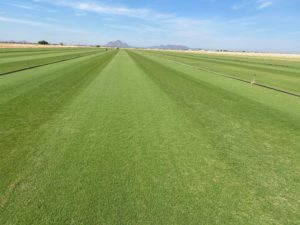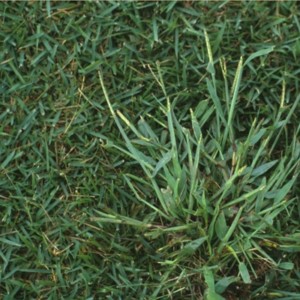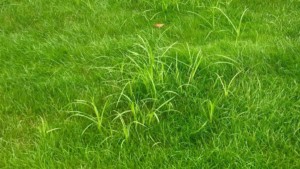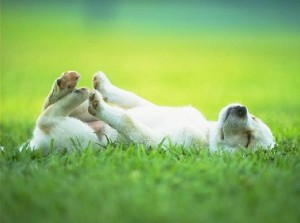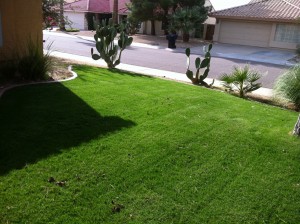Oct
Frequently Asked Questions About Overseeding Your Warm Season Lawn
Now that we’re into October it’s time to get the overseeding of your warm season grass process started. I wanted to pass along some of the most frequently asked questions during this time of the year.
When is the best time to start overseeding?
Ideally overseeding should be done when nighttime temperatures are consistently in the 60’s. Usually this will be in October. There will be some higher and lower than normal temperatures, but anytime during October is good.
How low do I need to scalp the grass prior to seeding?
Height of cut isn’t as important as opening the turf canopy. The shorter you mow the grass, the tighter the turf canopy will be which will result in the need to verticut more aggressively. I recommend not going lower than ½”. There is no need to take the lawn to the dirt or you will cause long term problems to the grass plant.
Jan
Weed Control Tips for Your California and Arizona Lawn
2017 has started out nicely with some timely rainfalls to keep most of you from having to water your lawn. It has also helped us move closer to getting out of the drought we’ve been suffering from for the last few years. The winter storms are helping us replenish our water supplies but they’re also helping germinate all of those of those summer annual weeds in the soil. The good news is weeds are relatively easy to contain. There are some types such as annual bluegrass, crabgrass, and nutsedge that are a little more complicated but timing pre-emergent herbicide applications can save you a lot of headaches with weed control. In this blog I will go over various weeds and some ways to control them as well as discuss herbicide timing.
Weed control management is a function of several different factors but some of the things you can do to keep your lawn healthy are maintain the proper mowing height, don’t overwater your lawn, fertilize monthly, and aerate the turf when the soil becomes compacted. These items right here can be the difference between weeds slowly emerging in your lawn and taking over your lawn. A healthy lawn will push out weeds and keep them to a minimum. If you have very few weeds emerge during the year chemical application is unnecessary and weeds can be pulled by hand as they appear.
Comments Off on Weed Control Tips for Your California and Arizona Lawn
Dec
Winter Tips for Your Lawn
Cold temperatures have arrived in California and Arizona, and those of you with overseeded sod may begin to see your lawn go in a little shock. One of the things you will notice first is bermudagrass going dormant in the turf causing small quarter sized yellow spots in your lawn. This is nothing to be concerned about as today we will discuss getting those spots to fill in. If you didn’t overseed your lawn for the winter it’s most likely dormant at this point and you can sit back and let your lawn sleep for a few months.
I’m sure many of you have seen the small yellow spots over the years in your overseeded lawn. The question is what is causing it and what can you do about it? First, this isn’t something to be concerned about. It’s actually a sign that you had a very healthy lawn going into the overseed season. Since many people overseed in late September/early October you’re still fighting with warm season growth. By supplying water and fertilizer to overseed the bermudagrass continues to grow and has a tendency to out compete your newly seeded ryegrass. When you’re overseeded lawn first start growing it looks immaculate, but it’s good to remember some of this is bermudagrass. The bermudagrass/ryegrass combination looks incredible and when it’s growing in it can be tough to distinguish the two.
Comments Off on Winter Tips for Your LawnApr
April Lawn Transition Tips
For most parts of the country spring means a return to warmer temperatures and usually some good rain storms. For the desert southwest this typically means hot temperatures and the occasional rain event. We were lucky enough to get some late season El Niño storms this month which will have a nice impact on our warm season grasses.
The transition season has officially begun and over the next month you will start to see your underlying warm season grass start to push out the winter ryegrass. The hot temperatures will start to take their toll on the ryegrass and it will start to die out. It’s not uncommon to start to see dry patches emerge in your lawn that looked perfect the week prior.
As much as it may pain you to see sections of your beautiful lawn start to die back remember this is a good thing. Sections of your lawn will always dry out before others areas simply because of the soil texture, compaction, or sprinkler coverage. It’s important to rule out sprinkler issues and if it is merely a transition dry spot rest easy. For these spots I recommend taking a hard toothed rake and rake up the dead ryegrass that lies on the surface. This dead material is shading out the bermudagrass down below and preventing it from getting water and sunlight. Keeping your lawn mowed below ¾” during this time of the year and power raking or verticutting will also help remove dead material from shading your summer grass.
Comments Off on April Lawn Transition TipsAug
Evaluating Your Summer Lawn
As we move through the dog days of summer in California and Arizona, now is a good time to evaluate your turfgrass lawn. The summer is the optimal time to grow warm season turfgrasses so it is important to get good growth before the end of the season. The golden rule is that all warm season grasses need to have 100 days of growing without any competition in order to maintain their health. That is 100 days without any lingering ryegrass in the way. Think back to when the ryegrass was completely out of your lawn? Was it June or did it hang around until July? If you didn’t transition it by mowing lower and verticutting then most likely you still had some ryegrass until the humidity increased and wiped it out in July. Read the rest of this entry »
Comments Off on Evaluating Your Summer LawnJun
Dog Urine and Your Turfgrass–Can’t We All Just “Get a Lawn?”
Pets are as much a part of our families as our kids, and keeping them happy is important. Do you know what makes for a happy dog? A beautiful lawn!
Did you know that putting in grass has been shown to reduce ground temperatures by as much as 30 degrees? We continually see a trend for people to use rocks in their yards because they don’t like the perceived maintenance of a yard. In this day and age it is important to think about the environment. Sod cleans the air and helps recharge our groundwater supplies. Turfgrass is one of nature’s finest and least expensive filters, and works to improve the environment. The front lawn of just 8 homes has the cooling effect of 70 tons of air conditioning. Just think how happy you and your pets would be to walk around during the summer months if everyone had natural grass in their yard. You can have a beautiful lawn and be responsible if you water wisely. Grass doesn’t waste water–people waste water.
Comments Off on Dog Urine and Your Turfgrass–Can’t We All Just “Get a Lawn?”May
Soil Prep/Lawn Establishment
With the rising temperatures we have quickly entered the best time of the year to plant sod. I’m sure a few of you just read the first sentence and thought that I was crazy since we’re hitting 105-110 degrees most days. Warm season turf is so well adapted to this type of weather that establishing a lawn during the summer is a simple process with the right prep work and follow up. I’m going to outline some simple cost effective steps for those looking to put in a lawn this summer.
Living in the desert we all know that water is scarce so we want to do our best to preserve it and not overuse it. One of the best water saving tips is putting in an automatic sprinkler system. Before I proceed I will tell you that I don’t recommend putting in a new lawn without one. A good sprinkler system will allow you to put out the correct amount of water in a given period of time and will help eliminate waste.
Setting up a manual sprinkler or hose is inefficient, time consuming, and most of all it is very tough to gauge the amount of water you actually put out. Before putting in an irrigation system you should by a small gauge to check your homes water pressure. Knowing how much water pressure you have will determine how many sprinklers can be on each valve. Depending on the area you will be watering you may need a couple to several valves to correctly operate your irrigation system. Most sprinkler systems are set up with a valve that controls the drip lines to the plants and then a valve for each section of the turf. A home with 1000 square feet of turf will typically have two valves to control the lawn. If you have very low water pressure you will probably need to add a third valve so less sprinklers are running at one time.
Comments Off on Soil Prep/Lawn Establishment
May
SPRING TRANSITION FAQ
The word transition tends to conjure up some ugly thoughts in people’s minds. Transition is often used to describe moving from one stage to another or in the case of sports teams are often transitioning from one style of play to another. Fans of sports teams cringe when they hear the word transition and the same is true for most turf managers but with turf it is often an easy fix. My goal today is to answer some frequently asked questions on transition, sod install, fertilizer and watering for the summer. If you have another question that I didn’t list please let me know.
Q. I overseeded my lawn last fall and I can’t get the ryegrass to die off. Can I turn the water off and kill it?
A. Yes and no. You can turn the water off and severely stunt or kill the ryegrass but you will also do some serious harm to your warm season turf. It is best to cut your water back 30-40% and let it fade away with the warmer temperatures.
Comments Off on SPRING TRANSITION FAQOct
Watering Your Turf
By now most of you have overseeded for the fall or made the decision to let your turf go dormant for the winter. I think now is an appropriate time to talk about the best way to control your water bill and at the same time give your grass the best chance of thriving. Our extreme summers often give homeowners the wrong idea of just how much water is necessary to grow a green lawn. Read the rest of this entry »
Comments Off on Watering Your TurfSep
Overseeding Your Lawn 101
We’re getting closer to the overseeding process! I am sure many of you reading my blog have started to see perennial ryegrass arriving in stores by the truck full, but we are still a little early. It isn’t too early to start some of the initial prep work, but it is still a little hot to drop seed. I realize that some of you won’t have a choice in the timing of overseeding, but if you do have a choice it is best to wait. Today’s blog is going to give you 10 easy steps on how to overseed and establish a great lawn for the winter. I have also attached a short video on doing so. www.youtube.com
Comments Off on Overseeding Your Lawn 101
